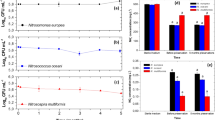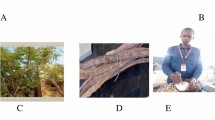Abstract
The detection and enumeration of indicator bacteria such as Escherichia coli is used to assess the extent of faecal contamination of drinking water. On the basis of this approach, the effectiveness of storing water contaminated with faecal indicator bacteria in brass or earthern vessels (mutkas) of the type used in rural India have been investigated. Suspensions of bacteria in sterile distilled water were maintained for up to 48 h in each vessel and enumerated by surface plate counts on nutrient agar (non-selective) and several selective coliform media at 37 °C either under standard aerobic conditions, or under conditions designed to neutralise reactive oxygen species (ROS), e.g. using an anaerobic cabinet to prepare plates of pre-reduced growth medium or by inclusion of sodium pyruvate in the growth medium, with incubation of aerobically-prepared plates in an anaerobic jar. The counts obtained for E. coli decreased on short-term storage in a brass mutka; counts for selective media were lower than for equivalent counts for non-selective medium, with ROS-neutralised conditions giving consistently higher counts than aerobic incubation. However, after 48 h, no bacteria were cultivable under any conditions. Similar results were obtained using water from environmental sources in the Panjab, and from rural households where brass and earthern mutkas are used for storage of drinking water, with enumeration on selective coliform media (presumptive total coliforms). In all cases results indicated that, while storage of water in a brass mutka can inactivate E. coli and coliforms over a 48 h period, standard aerobic plate counting using selective media may not be fully effective in enumerating sub-lethally damaged bacteria.
Similar content being viewed by others
Abbreviations
- mFC-R:
-
membrane faecal coliform agar without rosolic acid
- mLSA:
-
membrane lauryl sulphate agar
- ROS:
-
reactive oxygen species
References
T.G. Aldsworth R.L. Sharman C.E.R. Dodd (1999) ArticleTitleBacterial suicide through stress Cell. Mol. Life. Sci. 56 378–383 Occurrence Handle10.1007/s000180050439 Occurrence Handle1:CAS:528:DyaK1MXntleqsL8%3D Occurrence Handle11212292
InstitutionalAuthorNameAnon (2000) Anaerocult® A product information sheet Merck VWR Diagnostics Darmstadt
InstitutionalAuthorNameAnon (2002) The Microbiology of Drinking Water (2002) – Part 1 – Water Quality and Public Health. Methods for the Examination of Waters and Associated Materials Environment Agency London
G.K. Bissonnette J.J. Jezeski G.A. McFeters D.G. Stuart (1974) ArticleTitleInfluence of environmental stress on enumeration of indicator bacteria from natural waters Appl. Microbiol. 29 186–194
G. Bogosian N.D. Aardema E.V. Borneuf P.J.L. Morris J.P. O’Neil (2000) ArticleTitleRecovery of hydrogen peroxide-sensitive culturable cells of Vibrio vulnificus gives the appearance of resuscitation from a viable but nonculturable state J. Bacteriol. 182 5070–5075 Occurrence Handle10.1128/JB.182.18.5070-5075.2000 Occurrence Handle1:CAS:528:DC%2BD3cXmsVOqtbs%3D Occurrence Handle10960089
J.P. Calabrese G.K. Bissonnette (1990a) ArticleTitleImproved membrane filtration method incorporating catalase and sodium pyruvate for detection of chlorine stressed coliform bacteria Appl. Environ. Microbiol. 56 3558–3564 Occurrence Handle1:CAS:528:DyaK3MXkvFamsQ%3D%3D
J.P. Calabrese G.K. Bissonnette (1990b) ArticleTitleImproved detection of acid mine water stressed coliform bacteria on media containing catalase and pyruvate Can. J. Microbiol. 36 544–550 Occurrence Handle1:CAS:528:DyaK3cXmtFOmu7c%3D
L.S. Clesceri A.D. Eaton A.E. Greenberg (1998) Standard Methods for the Examination of Water and Wastewater20th ed American Public Health Organisation Washington
J.A. Crump G.O. Okoth L. Slutsker D.O. Ogaja B.H. Keswick S.P. Luby (2004) ArticleTitleEffect of point-of-use disinfection, flocculation and combined flocculation-disinfection on drinking water quality in western Kenya J. Appl. Microbiol. 97 225–231 Occurrence Handle10.1111/j.1365-2672.2004.02309.x Occurrence Handle1:CAS:528:DC%2BD2cXmtl2nu7Y%3D Occurrence Handle15186460
S.M. Czechowitz O. Santos E.A. Zottola (1996) ArticleTitleRecovery of thermally stressed Escherichia coli O157:H7 by media supplemented with pyruvate Int. J. Food Microbiol. 33 275–284 Occurrence Handle10.1016/0168-1605(96)01116-6 Occurrence Handle8930711
M.J. Domek M.W. Lechevallier S.C. Cameron G.A. McFeters (1984) ArticleTitleEvidence for the role of copper in the injury process of coliform bacteria in drinking water Appl. Environ. Microbiol. 48 289–293 Occurrence Handle1:CAS:528:DyaL2cXltlKlsLk%3D Occurrence Handle6385846
M.J. Domek J.E. Robbins M.E. Anderson G.A. McFeters (1987) ArticleTitleMetabolism of Escherichia coli injured by Copper Can. J. Microbiol. 33 57–62 Occurrence Handle1:CAS:528:DyaL2sXhtlGjsrg%3D Occurrence Handle3552166
S.M. George L.C.C. Richardson I.E. Pol M.W. Peck (1998) ArticleTitleEffects of oxygen concentration and redox potential on recovery of sublethally heat-damaged cells of Escherichia coli O157:H7, Salmonella enteritidis and Listeria monocytogenes J. Appl. Microbiol. 84 903–909 Occurrence Handle10.1046/j.1365-2672.1998.00424.x Occurrence Handle1:CAS:528:DyaK1cXks1aqu7o%3D Occurrence Handle9674145
B. Grey R.T. Steck (2001) ArticleTitleConcentrations of copper thought to be toxic to Escherichia coli can induce the viable but nonculturable condition Appl. Environ. Microbiol. 67 5325–5327 Occurrence Handle10.1128/AEM.67.11.5325-5327.2001 Occurrence Handle1:CAS:528:DC%2BD3MXotlSnsb8%3D Occurrence Handle11679363
A. Hassen N. Jedidi M. Chérif A. M’hiri A. Boudabous O. Van Cleemput (1998) ArticleTitleMineralization of nitrogen in a clayey loamy soil amended with organic waste residues enriched with Zn, Cu and Cd Bioresour. Technol. 64 39–45 Occurrence Handle10.1016/S0960-8524(97)00153-3 Occurrence Handle1:CAS:528:DyaK1cXjt1Slu70%3D
R.B. Jonas (1989) ArticleTitleAcute copper and cupric ions toxicity in an estuarine microbial community Appl. Environ. Microbiol. 55 43–49 Occurrence Handle1:CAS:528:DyaL1MXptVWitQ%3D%3D
D.H. Kang G.R. Siragusa (1999) ArticleTitleAgar underlay method for recovery of sub lethally heat injured bacteria Appl. Environ. Microbiol. 65 5334–5337 Occurrence Handle1:CAS:528:DyaK1MXnvVGjt7g%3D Occurrence Handle10583985
Keevil C.W. 2000. Copper Pipes Kill the Burger Bug in Drinking Water. In: 100th General Meeting of the American Society for Microbiology, Los Angeles, Q79.
C.W. Keevil J.T. Walker A. Maule B.W. James (1999) Persistence and physiology of Escherichia coli O157:H7 in the environment G. Duffy P. Garvey J. Coia W. Wasteson D. McDowell (Eds) Verocytotoxigenic E. coli in Europe: Survival and Growth Teagasc Dublin 42–52
Khaengraeng R. and Reed R.H. in press. Oxygen and photoinactivation of Escherichia coli in UVA and sunlight: implications for solar water treatment. J. Appl. Microbiol.
A.E.M. Khairy O.E. Sebaie A.A. Gawad E.L. Attar (1982) ArticleTitleThe sanitary condition of rural drinking water in a Nile Delta villageI: parasitological assessment of ‘Zir’ stored and direct tap water J. Hyg. Camb. 88 57–61 Occurrence Handle1:STN:280:Bi2C387ht1U%3D Occurrence Handle7057027
J. Kielemoes W. Verstraete (2001) ArticleTitleInfluence of copper-alloying of austenitic stainless steel on multi-species biofilm development Lett. Appl. Microbiol. 33 148–152 Occurrence Handle10.1046/j.1472-765x.2001.00967.x Occurrence Handle1:CAS:528:DC%2BD3MXmt1Sntbo%3D Occurrence Handle11472524
M. Kosek C. Bern R.L. Guerrant (2003) ArticleTitleThe global burden of diarrhoeal diseaseas estimated from studies published between 1992 and 2000 Bull. World Health Organ. 81 197–204 Occurrence Handle12764516
D.C. McBrian (1980) ArticleTitleAnaerobic potentiation of copper toxicity and some environmental considerations CIBA Found. Symp. 79 310–318
G.A. McFeters J.S. Kippin M.W. LeChevallier (1986) ArticleTitleInjured coliform in drinking water Appl. Environ. Microbiol. 51 1–5 Occurrence Handle1:STN:280:BimC2Mjlt10%3D Occurrence Handle3513698
E.D. Mintz J. Bartram P. Lochery M. Wegelin (2001) ArticleTitleNot just a drop in the bucket: expanding access to point-of-use water treatment system Am. J. Pub. Health. 91 1565–1570 Occurrence Handle1:STN:280:DC%2BD3MrivFyntQ%3D%3D Occurrence Handle11574307
Y. Mizunoe S.N. Wai A. Takade S. Yoshida (1999) ArticleTitleRestoration of culturability of starvation-stressed and low-temperature stressed Escherichia coli O157:H7 cells by using H2O2 degrading compounds Arch. Microbiol. 172 63–67 Occurrence Handle10.1007/s002030050741 Occurrence Handle1:CAS:528:DyaK1MXmsVyitbk%3D Occurrence Handle10398754
C.U. Nageli (1893) ArticleTitleOligodynamische Ercheinungen in labenden Zellen Deuksch. Schweiz. Naturgesell. 33 1–43
A.R. Patwardhan (1990) Our Water Our Life Council for Advancement of People’s Action and Rural Technology Delhi
R. Pedazhur H.I. Shuval S. Ulitzur (1997) ArticleTitleSilver and hydrogen peroxide as potential drinking water disinfectants: their bactericidal effects and possible modes of action Water Sci. Technol. 35 87–93 Occurrence Handle10.1016/S0273-1223(97)00240-0
R.H. Reed (2004) ArticleTitleThe inactivation of microbes by sunlight: solar disinfection as a water treatment process Adv. Appl. Microbiol. 54 333–365 Occurrence Handlefull_text||10.1016/S0065-2164(04)54012-1 Occurrence Handle1:CAS:528:DC%2BD2cXnvVWjtL8%3D Occurrence Handle15251286
D.P. Sartory (1995) ArticleTitleImproved recovery of chlorine-stressed coliforms with pyruvate supplemented media Water Sci. Technol. 31 255–258 Occurrence Handle10.1016/0273-1223(95)00276-S
D.P. Sartory L. Howard (1992) ArticleTitleA medium detecting β-glucuronidase for the simultaneous membrane filtration enumeration of Escherichia coli and coliforms from drinking water Lett. Appl. Microbiol. 15 273–276
P.J. Stephens P. Druggan N.V. Caron (2000) ArticleTitleStressed Salmonella are exposed to reactive oxygen species from two independent sources during recovery in conventional culture media Int. J. Food Microbiol. 60 269–285 Occurrence Handle10.1016/S0168-1605(00)00345-7 Occurrence Handle1:CAS:528:DC%2BD3cXmtF2rtb0%3D Occurrence Handle11016616
Sunda W.G. and Huntsman S.A. 1998. Processes regulating cellular metal accumulation and physiological effects: phytoplankton as model systems. Sci. Total Environ. 219: 165–181.
InstitutionalAuthorNameWHO (2002a) Managing Water in the Home: Accelerated Health Gains from Improved Water Supply Sanitation and Health Department of Protection of Human Environment. World Health Organisation Geneva
InstitutionalAuthorNameWHO (2002b) Evaluation of the H2S Method for Detection of Faecal Contamination of Drinking Water Sanitation and Health Department of Protection of Human EnvironmentWorld Health Organisation Geneva
InstitutionalAuthorNameWHO (2004) Guidelines for Drinking-water Quality Volume 1: Recommendations, 3rd ed World Health Organisation Geneva
J. Wright S. Gundry C. Ronam (2004) ArticleTitleHousehold drinking water in developing countries: a systematic review of microbiological contamination between source and point of use Trop. Med. Int. Health. 9 106–117 Occurrence Handle10.1046/j.1365-3156.2003.01160.x Occurrence Handle14728614
Author information
Authors and Affiliations
Corresponding author
Rights and permissions
About this article
Cite this article
Tandon, P., Chhibber, S. & Reed, H.R. Inactivation of Escherichia coli and coliform bacteria in traditional brass and earthernware water storage vessels. Antonie Van Leeuwenhoek 88, 35–48 (2005). https://doi.org/10.1007/s10482-004-7366-6
Received:
Accepted:
Issue Date:
DOI: https://doi.org/10.1007/s10482-004-7366-6




